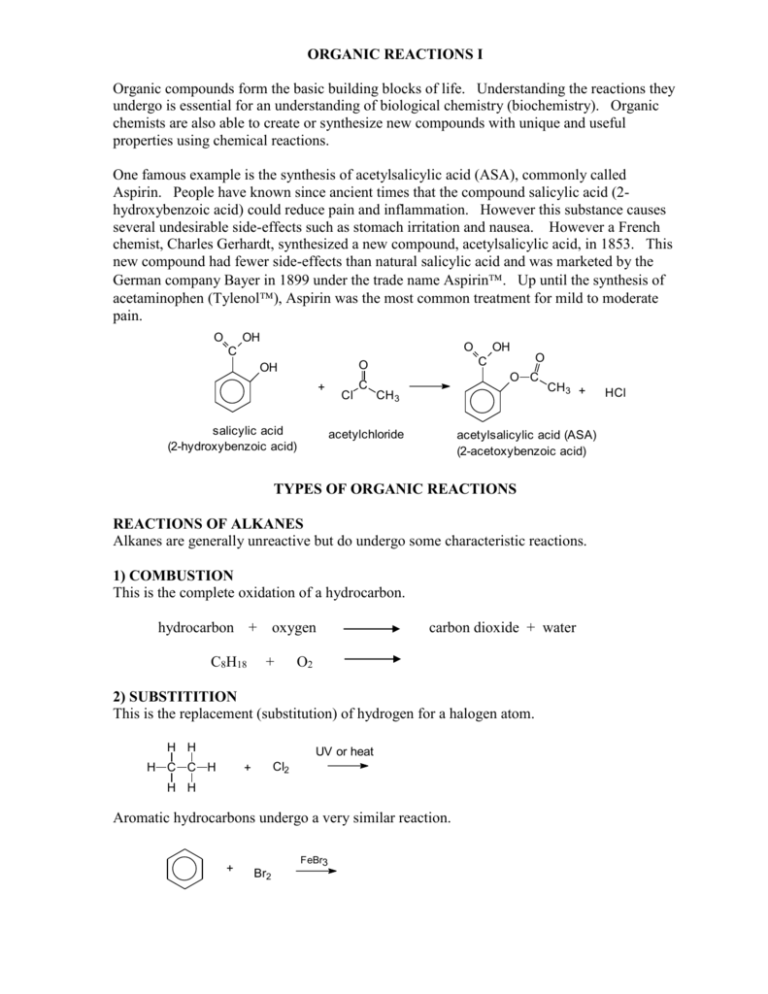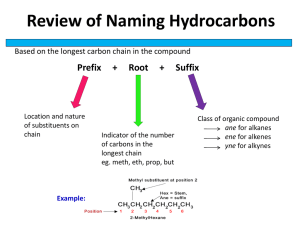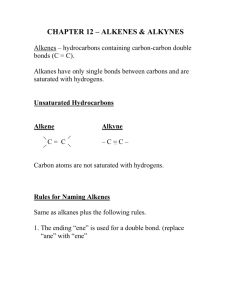ORGANIC REACTIONS I
advertisement

ORGANIC REACTIONS I Organic compounds form the basic building blocks of life. Understanding the reactions they undergo is essential for an understanding of biological chemistry (biochemistry). Organic chemists are also able to create or synthesize new compounds with unique and useful properties using chemical reactions. One famous example is the synthesis of acetylsalicylic acid (ASA), commonly called Aspirin. People have known since ancient times that the compound salicylic acid (2hydroxybenzoic acid) could reduce pain and inflammation. However this substance causes several undesirable side-effects such as stomach irritation and nausea. However a French chemist, Charles Gerhardt, synthesized a new compound, acetylsalicylic acid, in 1853. This new compound had fewer side-effects than natural salicylic acid and was marketed by the German company Bayer in 1899 under the trade name Aspirin. Up until the synthesis of acetaminophen (Tylenol), Aspirin was the most common treatment for mild to moderate pain. O C OH O O OH + salicylic acid (2-hydroxybenzoic acid) Cl C C OH O O C CH3 acetylchloride CH3 + acetylsalicylic acid (ASA) (2-acetoxybenzoic acid) TYPES OF ORGANIC REACTIONS REACTIONS OF ALKANES Alkanes are generally unreactive but do undergo some characteristic reactions. 1) COMBUSTION This is the complete oxidation of a hydrocarbon. hydrocarbon + oxygen C8H18 + carbon dioxide + water O2 2) SUBSTITITION This is the replacement (substitution) of hydrogen for a halogen atom. H H H C C H Cl2 + UV or heat H H Aromatic hydrocarbons undergo a very similar reaction. + Br2 FeBr3 HCl 3) a) ADDITION WITH Br2 or Cl2 The unsaturated hydrocarbons are much more reactive due to the presence of the double or triple bonds. H H C C H + Br2 H During the reaction, the red colour of bromine disappears as it reacts. Since alkanes do not react with halogens at room temperature, this can be used as a test for the presence of unsaturated hydrocarbons. b) ADDITION OF HYDROGEN (HYDROGENATION ) H H C C H H + H2 Pt catalyst heat. pressure c) ADDITION WITH HCl or HBr H H C C H + H HBr d) ADDITION WITH WATER H H C C H H + HOH H3O+ Markovnikov’s Rule If the more than one product is possible, the more electronegative atom will end up on the carbon atom of the double bond that has the fewer hydrogens. This rule is known as Markovnikov’s Rule. + CH3 CH CH2 CH3 C CH + H2O H3O+ 2HBr 4) ELIMINATION REACTIONS The addition reaction of an alkene and water can be made to go in reverse. This is also called a dehydration reaction. H OH H C C H H H conc. H2SO4 5) MILD OXIDATION REACTIONS Complete oxidation of an organic compound forms carbon dioxide and water (Reaction 1). However a controlled oxidation of an alcohol can be used to create other functional groups. Using oxidizing agents such as KMnO4, K2Cr2O7 or H2O2, the following sequence of reactions is possible: alcohol aldehyde ketone carboxylic acid a) Primary alcohols H OH H2O2 H C C H H H b) Secondary Alcohols OH H2O2 CH3 CH CH3 c) Tertiary Alcohols OH CH3 C CH3 H2O2 CH3 QUESTIONS Handout Questions Textbook (p. 31 #1-4; p.44 #7,8; p.56 #6); p. 56 #6 Types of Organic Reactions 1. Identify the type of organic reaction represented by each of the following equations: a. H H H C C H H H + H H C C H H heat Br Br H Br + HBr b. H H H C C H H + C H2O H H H H H C C C H OH H c. Cl H3C C CH + 2HCl H3C C Cl CH3 H d. H H C H C C H Br H C C H H H C + H Br Br H C H C H C H H C H C H H H H e. C Br H OH CH2 CH2 HC conc. H2SO4 H2C H2C CH2 CH2 CH CH CH2 CH2 CH2 f. H H C H K2Cr2O7 C H C H H g. H O H H H C C C H H H O C OH H H + 2 Cl Cl H H Cl Cl C C C H H H H + 2 HCl NO 2 h. CH CH HC CH + CH CH HNO3 C HC CH CH CH CH 2. Write the equation for the addition reaction involving propene and bromine. 3. Complete the following equations by writing the structures of the products that form. If no reaction occurs, write “no reaction”. a. H3C CH H3C CH CH2 + H2O acid catalyst b. c. CH CH3 + H2O acid catalyst Br + Br2 (3 possible products but ortho isomer is favoured) d. H3C CH2 CH2 CH3 + HO 2 e. OH conc. H2SO4 + H2O f. O C H3C + CH3 K2Cr2O7 g. CH2 H3C O CH + K2Cr2O7 + H2SO4 h. CH CH3 H3C +H , pressure 2 CH Pt catalyst 4. a) Write the equation for the complete oxidation (combustion) of 2-butanol. b) Write the equation for the mild oxidation of 2-butanol with KMnO4. 5. Write the equation for the addition of hydrochloric acid to ethene. What is the name of the product formed? 6. Predict the product formed when HCl is reacted with each of the following compounds. Use Markovnikov’s Rule to predict the product. a. H3C CH H3C CH3 C b. H3C c. H3C CH2 C H C CH 7. Describe the chemical test that could be carried out to distinguish between hexane and hexene. 8. Write the equation for the substitution reaction involving one molecule of each of ethane and bromine. 9. What is the structure of the missing organic reactant in each of the following: + , pressure H2 Pt Catalyst 10. Write the structure of the carboxylic acid that forms when the following aldehyde is oxidized: CH2 H3C O CH 11. Which of these two compounds is easily oxidized by KMnO4? Write the structure of the organic product of the oxidation. O a. H3C CH3 O b. H3C CH2 C H 12. What are the products of the mild oxidation of a. 1-propanol b. 2-propanol 13. a) Draw the following expanded structures for these compounds. C2H6 C2H5OH CH3CHO CH3COOH CO2 b)Using oxidation numbers for carbon, show that this sequence of compounds represents an oxidation process:






